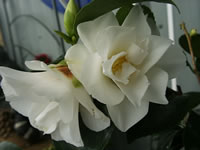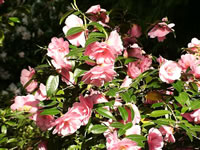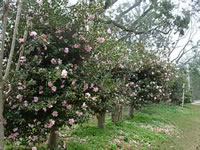|
Camellias are generally not heavy feeders but if growth is weak or the leaves begin to turn yellow,
they should be fertilized in late winter or very early in the spring when new growth begins, using a slow-release,
Rhododendron type fertilizer applied sparingly around the drip line of the plant.
Always water fertilized plants thoroughly after the application.
Spreading fertilizer directly beneath Camellias can result in burning the shallow, tender new roots.
Always follow label directions carefully!
Camellias seldom require pruning, but if they become overgrown, they can be pruned back as necessary
immediately after blooms fade or in mid-summer. Remove weak, spindly or dead branches.
Thin out the inner branches and shorten lower limbs to encourage upright growth..
Planting Camellias
Camellias should be planted or transplanted during the fall and winter months.
The planting depth is critical for Camellias. If the root ball is set too deep, your Camellia may refuse to bloom.
Prior to planting your Camellia, prepare the planting site by mixing in generous amounts of peat moss,
compost or processed manure with the existing soil.
Dig the planting hole twice the diameter root ball and about 1½ the depth.
Add enough of the prepared soil to the hole so that when you place the root ball in, the top of it
will be about an inch above the existing soil level, to allow for settling.
Place the plant into the new planting hole and add the remaining soil, tamping it down as you fill.
Water heavily, to settle the soil and remove air pockets in the soil.
Keep well watered until your Camellia is well established.
Add a thick layer of mulch (2"-3" of leaf mold or shredded bark) to help maintain moisture.
Propagating Camellia Plants and Growing them from Seed
|
The fastest and most reliable method of propagating new Camellia plants is by air layering. This method will allow you to create much larger clones.
Air layering of Camellias can be done at any time of the year but the best results are accomplished if the process is done in the spring when the plant is actively growing.
Camellias can also be propagated with softwood cuttings taken from new growth in early summer, but it is a slow process. Each cutting should have at least 5 nodes.
Remove the lowest leaves and trim the remaining leaves by one half
before inserting the cutting into a sand/peat moss mix.
Camellia seeds harvested from hybrid plants may be sterile, and those that are viable may produce plants that are not true to their parent.
Soak Camellia seeds in warm water for 24 hours before sowing them indoors during the spring or fall.
Maintain a temperature in the growing medium of 70°-75° until germination, which takes 1-2 months.
|
|
Japanese Camellia
Camellia japonica
 |
 |
 |
Sasanqua Camellia
Camelia sasanqua
 |
 |
|





